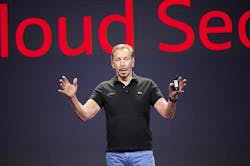Oracle Hits Every Major Cloud via AWS, Reveals Plans for Gigawatt Triple SMR Data Center
At the beginning of this year in our "Eight Themes That Will Shape the Data Center Industry in 2024" forecast, we made the observation that Oracle’s cloud revenue growth was only being slowed by the pace of its cloud deployments.
“Frankly, the only limiting factor is our ability to get the data centers handed over and filled up fast enough,” said Oracle CEO Safra Catz in the company’s Q3 earnings call last year. “This quarter alone, we're talking about hundreds of millions of dollars that we would have been able to recognize if our capacity was available.”
Thus, it's not surprising that a major trendline for Oracle this year seems to have become securing that capacity.
Industry analyst, board member and author Bill Kleyman, who is also CEO and Co-Founder of data center AI transformation specialist Apolo.us, and a notable, periodic contributor to Data Center Frontier's stream of expert industry views, this week reported on numerous, key updates by Oracle from the floor of this week's Oracle Cloud World 2024.
Kleyman reported on how Oracle's Chairman of the Board and Chief Technology Officer, Larry Ellison, briefed Oracle Cloud World attendees on his company's Open MultiCloud Era and associated AI and cloud security initiatives. Ellison briefed the crowd on the new Oracle Database @ AWS offering and the company's Exadata and 23ai autonomous and exascale initiatives set to go live this December.
Going In Hard On Cloud and Nuclear Energy
In a most likely non-apocryphal incident, Ellison supposedly told employees back in the early days of the World Wide Web upon the launch of Oracle 8i that he was thus betting the company on the internet, and if he was wrong, they were toast, but if he was right, they were golden.
History has confirmed that Oracle was not toast. But that lore seems to be past prologue to how Oracle is going in hard now on innovation for cloud data centers and AI power stop gaps of the advanced nuclear variety. In a separate LinkedIn post this week, Bill Kleyman notes Oracle's deep roots in computing for the federal government and the CIA, providing an extra dimension of context for the inevitability of this week's announcements.
On the cloud side, in a prelude earlier this year to this week's crowning AWS announcement, Ellison's company announced that Oracle Cloud Infrastructure would be joining with Azure AI, OpenAI, and Google Cloud. At Oracle Cloud World 2024, Ellison explained how Oracle MultiCloud now embeds the Oracle Cloud Data Center inside AWS.
He said the union enables the highest performance in terms of higher bandwidth and lower latency as the reportedly easy-to-use Provision Oracle Database now becomes available from AWS Console. Customers now also receive the benefit of the fault-tolerant and scalable Oracle Exadata Cluster hardware now resides at AWS, with the Oracle Exadata Database now effectively running inside.
Ellison also confirmed that Oracle now has over 160 public and private Oracle Data Centers. Kleyman noted that some of such data centers are as small as 25 kW, while others are as big as 800 megawatts (MW) with an infrastructure of CPUs and GPUs in RDMA network configuration, and for autonomous operating system and database configurations across applications including Fusion ERP, HCM, CX, NetSuite, Oracle Cerner Health and other industries.
"Actually, we're working on even bigger data centers already," said Ellison.
Finally from Oracle Cloud World, Kleyman reported that Ellison dove into some major AI and security platform updates for the company. Ellison said that while today many Oracle Cloud applications run on its Autonomous Database platform, in the very near future, all Oracle Cloud applications will run on the Oracle Autonomous Database.
"Most cyber attacks begin with human error," pointed out the Oracle chief. "The Autonomous Database eliminates that threat. No human labor, no human error."
Ellison also emphasized how Oracle's Gen2 cloud security across public and private clouds prizes discrete elements for data, application, and network security, and user identity. Ellison said the Oracle security platform essentially boils down to a matter of "our cyber defense robots vs. their cyber attack robots."
Nuclear SMRs to Cloud: This Is the Way
The Oracle Cloud World announcements set the stage nicely for the ascendant cloud giant's other blockbuster announcement this week, when Oracle Chairman and CTO Ellison told analysts that Oracle is designing a 1 gigawatt data center that will be powered by three small modular nuclear reactors (SMRs). CNBC provided a summary of the news.
“The location and the power place we’ve located, they’ve already got building permits for three nuclear reactors,” Ellison said. “These are the small modular nuclear reactors to power the data center. This is how crazy it’s getting."
Ellison didn't share where the data center will be built, or offer any timelines. But his comments move the discussion of SMRs and data centers even further to center stage. The world's largest, most bedrock IT companies are now embracing nuclear as a low-carbon path forward through a challenging energy landscape.
Rod Walton, Managing Editor for Microgrid Knowledge (MGK), had the scoop on Oracle's tipping point revelation of plans for a gigawatt data centers powered by three nuclear SMRs in a solid report for MGK, DCF's close co-brand in Endeavor Business Media.
Walton's story, which pulls in some commentary from last week's DCF Trends Summit, is excerpted below as follows:
Software and cloud-based services giant Oracle is the latest major tech company embracing the concept of small modular reactor (SMR) nuclear as the most energy dense and sustainable microgrid option for future data centers.
The stunning rise in data center energy demand brought on by the growth of artificial intelligence and cloud-based computing capacity is compelling many tech companies to pursue the possibilities of small nuclear power, although no SMR has yet been built or even licensed to begin construction for commercial purposes. Most industry observers predict that the earliest SMR projects would not come online until the 2030s. The only ones currently operating are in China and Russia. Idaho National Lab is currently testing advanced nuclear technologies.
The most recent conventional nuclear power project completed in the U.S., Southern Company’s 1-GW Vogtle 3 and 4 units, took close to a decade and more than $30 billion to complete.
Theoretically, SMR nuclear facilities would vary from 25 MW to 200 MW per unit, would be less expensive to build and partially underground to alleviate safety concerns. The reactors also could provide carbon-free, baseload-level power.
Industry analysts say that coming data center construction could require close to 40-plus GW of new electricity by early 2030. Utilities such as Dominion and AEP are scrambling to figure out ways of meeting that mission critical load expansion.
At last week’s Data Center Frontier Trends Summit, experts from data and energy companies noted that SMR nuclear could solve a lot of power resiliency and sustainability issues for the commercial and industrial sector. The event happened in Reston, Virginia, a region with more data centers than any other in the U.S., according to reports.
“We’re building our way to a (power) generation shortage,” Brian Jabek, vice president of business development at structural engineering firm Bennett & Pless, said during the event’s final energy-focused panel. “We need to get out of our own way and let nuclear grow up.”
Jabek previously worked for microgrid generation provider Enchanted Rock and is deeply experienced in onsite power solutions. He and others on the panel noted that SMRs, like any nuclear project, creates fear and safety concerns among many people and will face deep opposition.
At the same time, panelists noted, alternative energy resources such as solar, battery storage and hydrogen are also problematic and unlikely to meet future data center demand. So, they said, the road forward will be mainly powered by natural gas until new advanced reactors can be built and come online in the next decade.
The traditional path of centralized power must give way to more distributed resources closer to the load, proponents of SMRs say. Nuclear microgrids can provide reliability, flexibility and carbon reduction that tech companies seek.
Michael Turner, who is part of the Loudoun County Board of Supervisors in data center-rich northern Virginia, noted that future construction will overwhelm regional and municipal planners without distributed energy options. The bottleneck could force the issue to begin developing sited SMR projects.
“We should want a microgrid plan in place if we want to approve new ones,” Turner said of the planning and approval process at the local level.
Oracle is not alone in seeking future SMR nuclear power plants to intersect resiliency and sustainability goals. Earlier this year AWS signed a data center deal tying one of its Pennsylvania facilities to a nearby conventional nuclear power plant, while Microsoft, Diamondback Energy and other companies are pursuing agreements on developing next-gen nuclear connections and projects.
About the Author
Matt Vincent
A B2B technology journalist and editor with more than two decades of experience, Matt Vincent is Editor in Chief of Data Center Frontier.



